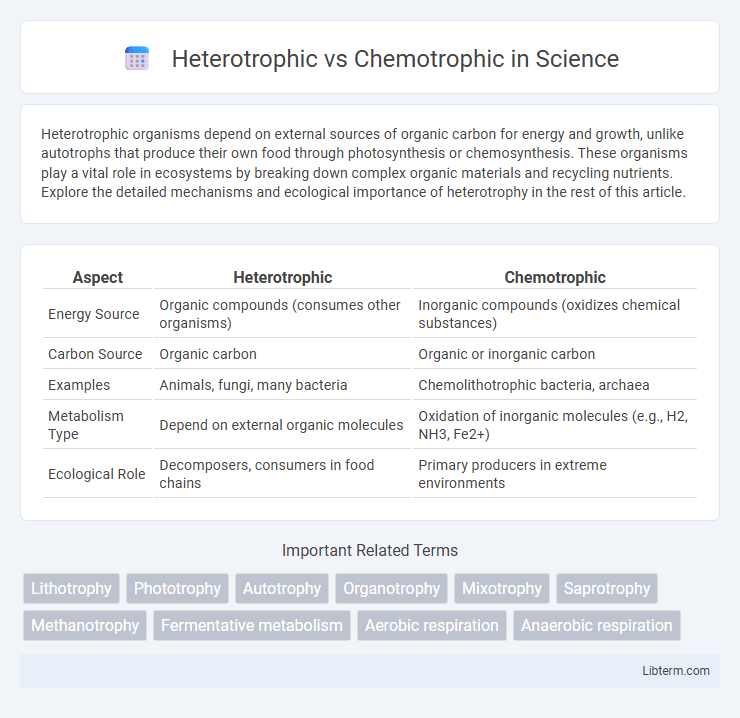Heterotrophic organisms depend on external sources of organic carbon for energy and growth, unlike autotrophs that produce their own food through photosynthesis or chemosynthesis. These organisms play a vital role in ecosystems by breaking down complex organic materials and recycling nutrients. Explore the detailed mechanisms and ecological importance of heterotrophy in the rest of this article.
Table of Comparison
| Aspect | Heterotrophic | Chemotrophic |
|---|---|---|
| Energy Source | Organic compounds (consumes other organisms) | Inorganic compounds (oxidizes chemical substances) |
| Carbon Source | Organic carbon | Organic or inorganic carbon |
| Examples | Animals, fungi, many bacteria | Chemolithotrophic bacteria, archaea |
| Metabolism Type | Depend on external organic molecules | Oxidation of inorganic molecules (e.g., H2, NH3, Fe2+) |
| Ecological Role | Decomposers, consumers in food chains | Primary producers in extreme environments |
Introduction to Metabolic Types
Heterotrophic organisms rely on organic compounds as both energy and carbon sources, metabolizing substances derived from other living organisms. Chemotrophic organisms obtain energy through the oxidation of inorganic or organic molecules, which can be further categorized into chemoautotrophs and chemoheterotrophs based on their carbon source utilization. These metabolic types define key ecological roles and energy flow in ecosystems, influencing biogeochemical cycles and organismal survival strategies.
Defining Heterotrophic Organisms
Heterotrophic organisms obtain energy and carbon by consuming organic compounds produced by other organisms, distinguishing them from chemotrophic counterparts that derive energy from chemical reactions involving inorganic or organic molecules. These heterotrophs include animals, fungi, and many bacteria, playing crucial roles in ecosystems by decomposing organic matter and recycling nutrients. Their reliance on preformed organic molecules makes them essential for energy flow and maintaining ecological balance in various habitats.
Overview of Chemotrophic Organisms
Chemotrophic organisms obtain energy by oxidizing inorganic or organic chemicals, differing fundamentally from phototrophs that rely on sunlight. These organisms are classified into chemoautotrophs, which fix carbon dioxide using chemical energy, and chemoheterotrophs, which consume organic compounds for both energy and carbon. Many chemotrophic bacteria occupy diverse environments, including deep-sea vents and soil, playing crucial roles in nutrient cycling and ecosystem functioning.
Key Differences Between Heterotrophs and Chemotrophs
Heterotrophs obtain energy by consuming organic compounds, relying on external sources of carbon for growth and metabolism. Chemotrophs derive energy from chemical reactions, utilizing either organic or inorganic substances as their energy source, and are classified into chemoorganotrophs and chemolithotrophs based on the chemical substrates used. The key distinction lies in heterotrophs' dependence on organic carbon for both energy and carbon, whereas chemotrophs focus on chemical energy extraction regardless of the carbon source.
Energy Sources: Organic vs. Inorganic
Heterotrophic organisms obtain energy by metabolizing organic compounds such as carbohydrates, fats, and proteins from other living or dead organisms. Chemotrophic organisms derive energy from the oxidation of inorganic substances like hydrogen sulfide, ammonia, or ferrous iron, enabling survival in environments devoid of sunlight. The metabolic pathways in heterotrophs rely on electron donors from organic molecules, whereas chemotrophs utilize inorganic electron donors to drive cellular respiration or chemolithotrophy.
Metabolic Pathways in Heterotrophs
Heterotrophic organisms rely on metabolic pathways such as glycolysis, the citric acid cycle, and oxidative phosphorylation to break down organic compounds for energy production. These pathways convert carbohydrates, lipids, and proteins into ATP through catabolic reactions using enzymes like hexokinase and pyruvate dehydrogenase. The efficiency of ATP generation in heterotrophs depends on the availability of oxygen, with aerobic respiration yielding significantly higher energy compared to anaerobic fermentation processes.
Chemotrophic Metabolism Explained
Chemotrophic metabolism involves organisms obtaining energy by oxidizing inorganic or organic compounds, rather than relying on sunlight like phototrophs. These chemotrophs can be classified into chemoautotrophs, which use inorganic molecules such as hydrogen sulfide or ammonia as energy sources, and chemoheterotrophs, which depend on organic compounds for both energy and carbon. This metabolic pathway plays a critical role in nutrient cycling and energy flow within ecosystems, especially in environments lacking sunlight.
Ecological Roles and Adaptations
Heterotrophic organisms obtain energy by consuming organic matter, playing crucial roles in decomposition and nutrient cycling within ecosystems. Chemotrophic organisms harness energy through the oxidation of inorganic compounds, often thriving in extreme environments such as hydrothermal vents and sulfur-rich habitats. Their adaptations include specialized enzymes for metabolizing chemical substrates and mechanisms to survive in low-light or oxygen-deficient conditions, contributing to ecosystem stability and biogeochemical processes.
Industrial and Environmental Applications
Heterotrophic organisms, relying on organic compounds for energy, are widely used in industrial fermentation processes to produce biofuels, pharmaceuticals, and enzymes, while chemotrophic organisms oxidize inorganic molecules, enabling applications in bioremediation and bioleaching for heavy metal recovery. In environmental contexts, heterotrophs play a critical role in organic waste decomposition and nutrient cycling, whereas chemotrophs contribute to environmental detoxification by transforming pollutants through chemolithotrophic metabolisms. The integration of heterotrophic and chemotrophic processes enhances sustainability and efficiency in waste management, pollutant degradation, and resource recovery systems.
Summary and Future Perspectives
Heterotrophic organisms obtain energy by consuming organic compounds, while chemotrophic organisms derive energy from inorganic chemical reactions, playing crucial roles in ecosystems and biogeochemical cycles. Emerging research focuses on exploiting chemotrophic microbes for sustainable bioenergy production and bioremediation, with genomic and metabolic engineering advancing their efficiency. Future perspectives include integrating synthetic biology to enhance metabolic pathways, enabling tailored bioprocesses that address environmental challenges and improve industrial applications.
Heterotrophic Infographic

 libterm.com
libterm.com